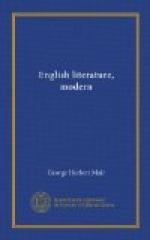It is in a territory poles apart from Mr. Kipling’s that the main stream of romantic poetry flows. Apart from the gravely delicate and scholarly work of Mr. Bridges, and the poetry of some others who work separately away from their fellows, English romantic poetry has concentrated itself into one chief school—the school of the “Celtic Revival” of which the leader is Mr. W.B. Yeats. Two sources went to its making. In its inception, it arose out of a group of young poets who worked in a conscious imitation of the methods of the French decadents; chiefly of Baudelaire and Verlaine. As a whole their work was merely imitative and not very profound, but each of them—Ernest Dowson and Lionel Johnson, who are both now dead, and others who are still living—produced enough to show that they had at their command a vein of poetry that might have deepened and proved more rich had they gone on working it. One of them, Mr. W.B. Yeats, by his birth and his reading in Irish legend and folklore, became possessed of a subject-matter denied to his fellows, and it is from the combination of the mood of the decadents with the dreaminess and mystery of Celtic tradition and romance—a combination which came to pass in his poetry—that the Celtic school has sprung. In a sense it has added to the territory explored by Coleridge and Scott and Morris a new province. Only nothing could be further from the objectivity of these men, than the way in which the Celtic school approaches its material. Its stories are clear to itself, it may be, but not to its readers. Deirdre and Conchubar, and Angus and Maeve and Dectora and all the shadowy figures in them scarcely become embodied. Their lives and deaths and loves and hates are only a scheme on which they weave a delicate and dim embroidery




